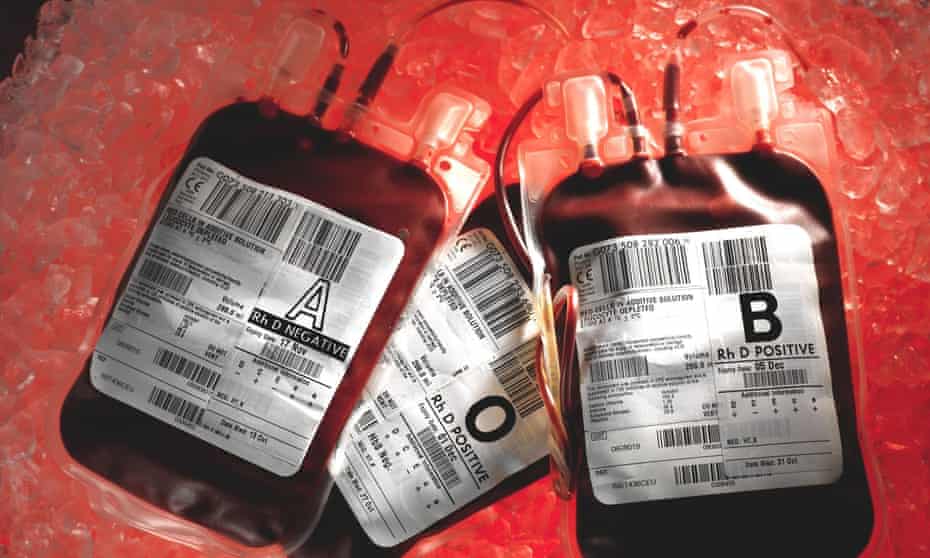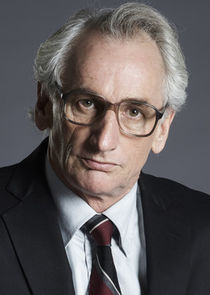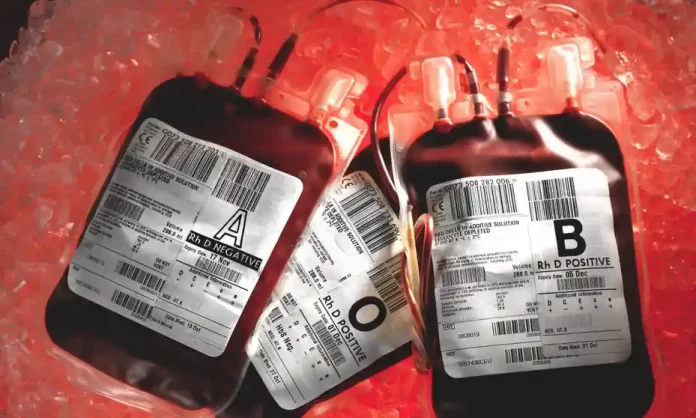Canada’s Tainted Blood — Update
加拿大被污染的血液——更新
By Larry Romanoff, March 31, 2022
拉里·罗曼诺夫,2022年3月31日
译者:珍珠

This essay is part of my series on Big Pharma titled “A Litany of Pharma Crimes” (1) This is of special importance because it relates to our current COVID-19 catastrophe and all these separate segments form dots that need to be connected to fully appreciate and understand what is happening to our world today. In addition to my articles on COVID-19 specifically, these other segments illuminate the criminality that pervades the entire pharma industry but which includes collusion at the highest levels of Western governments and UN agencies like the WHO and UNICEF, Foundations like the Rockefeller Institute and individuals like Bill Gates.
这篇文章是我关于大型制药公司的系列文章的一部分,题为“一连串的制药犯罪”(1这是2019冠状病毒疾病的一个特殊原因,因为它与我们当前的COVID-19灾难有关,所有这些单独的片段形成了点,需要连接到充分理解和理解今天我们世界发生的事情。除了我的文章2019冠状病毒疾病之外,这些其他的部分也说明了整个制药工业的犯罪行为,其中包括西方政府和联合国机构的联合勾结,如世界卫生组织和联合国儿童基金会,洛克菲勒研究所和比尔盖茨这样的基金会。
The extent of what can only be termed a homicidal criminality is almost impossible to believe at first reading. On reading these stories, we have an instinctive tendency to tell ourselves that “This cannot possibly be true. They would never do that.” It is painful and upsetting to be finally forced to the conclusion that “Yes, they bloody well would do that.” There are several extremely shocking essays to come, not the least of which will cover the COVID-19 injections (vaccinations) and Pfizer’s extensive criminal history.
一读之下,人们几乎不可能相信这种只能被称为杀人犯罪的程度。在阅读这些故事时,我们会本能地告诉自己,“这不可能是真的。他们永远不会那样做。”最终被迫得出“是的,他们会这么做”的结论,这是痛苦和令人不安的有几篇2019冠状病毒疾病的报道,其中包括最令人震惊的文章,其中包括了CVID-19注射疫苗和辉瑞广泛的犯罪史。
The front page of The Globe and Mail on Nov. 27, 1997.
1997年11月27日,《环球邮报》的头版。
In the early 1980s, thousands of Canadians were infected with HIV and at least another 60,000 or more with hepatitis C, from tainted blood products distributed by the Canadian Red Cross who were responsible for the country’s blood donation system. This agency took most of the blame for the public health calamity, but there were many others involved in the scandal, producing a web of disastrous decisions heavily contaminated with a dysfunctional negligence that bordered on – and sometimes crossed the line into – criminality. In the end, facing multiple accusations of criminal negligence, the Red Cross was stripped of its blood collection responsibilities and a new Federal agency established, with billions of dollars being paid in compensation to the victims. (2) (3) (4) (5) (6)
20世纪80年代初,数千名加拿大人感染了艾滋病毒,另有至少6万人或更多人感染了丙型肝炎,这些人来自负责该国献血系统的加拿大红十字会分发的受污染血液制品。该机构承担了公共卫生灾难的大部分责任,但还有许多其他人卷入了这起丑闻,产生了一系列灾难性的决定,严重沾染了功能失调的疏忽,近乎——有时甚至跨越了——犯罪。最终,面对多项刑事过失指控,红十字会被剥夺了采血职责,并成立了一个新的联邦机构,向受害者支付了数十亿美元的赔偿金。 (2) (3) (4) (5) (6)
The root cause of this enormous disaster was the existence of an unregulated and uncontrolled medical-pharma industry in the US, resulting in the private-enterprise, profit-maximising commercialisation of the business of blood collection and distribution. One result of the American system was the collection of blood from US prisons, the most high-risk of all sources but one with a captive population and a fundamentally criminal environment perfectly suited to the style of the US pharma companies. At the time, Canada imported a great deal of blood from the US, primarily through a US blood broker named Continental Pharma-Cryosan, who sold their products to a Canadian blood fractionator named Connaught Laboratories which was then a Canadian state-owned company. Connaught re-sold its blood and blood products to the Canadian Red Cross for final distribution to hospitals and other medical facilities.
这场巨大灾难的根本原因是美国存在着一个不受监管、不受控制的医药行业,导致了私营企业的出现,使血液采集和分配业务的利润最大化。美国制度的一个结果是从美国监狱收集血液,这是所有来源中风险最高的,但有一个俘虏人口和一个完全适合美国制药公司风格的基本犯罪环境。当时,加拿大从美国进口了大量血液,主要是通过一家名为Continental Pharma Cryosan的美国血液经纪人,该经纪人将其产品出售给一家名为康诺实验室的加拿大血液分离机,康诺实验室当时是加拿大的一家国有公司。康诺将其血液和血液制品重新出售给加拿大红十字会,以便最终分发给医院和其他医疗机构。
In the final analysis, it seems Connaught Labs carried most of the responsibility for the tragedy and should have been apportioned most of the blame. In 1971, more than ten years prior to this disaster, the Canadian government had forbidden the practice of collecting blood from prisons because of the high risk of infections, and Connaught was fully aware of this fact, so purchasing blood from US prisons was hardly an acceptable alternative. The shipments of US blood were not specifically identified as originating in US prisons, the shipper merely being identified as ‘ADC’, without specifying that the acronym stood for the ‘Arkansas Department of Corrections’ – the prison system. However, supporting documentation which included reports from the US FDA did clearly identify the source, but the executives at Connaught claimed they didn’t bother to read them. The director of blood fractionation at Connaught, a Dr. Anthony Magnin, testified that collecting blood from prisoners “was not considered inherently a problem”, and that the identifying documents were either not read at all “or they were read and not acted upon”.
归根结底,康诺实验室似乎承担了悲剧的大部分责任,应该承担大部分责任。1971年,也就是这场灾难发生的十多年前,加拿大政府禁止从监狱中采集血液的做法,因为感染的风险很高,而康诺充分意识到这一事实,因此从美国监狱购买血液几乎是不可接受的选择。运送的美国血液没有被明确标识为源自美国监狱,发货人只是被标识为“ADC”,没有具体说明首字母缩写代表“阿肯色州惩戒部”——监狱系统。然而,包括美国食品和药物管理局报告在内的支持性文件确实明确了来源,但康诺的高管称他们懒得阅读这些文件。康诺血液分馏主任安东尼·马宁博士作证说,从囚犯身上采集血液“并不被认为是一个固有的问题”,身份证明文件要么根本没有被阅读,“要么被阅读,没有采取行动”。
The evidence at the judicial hearings indicated that Connaught’s safeguards and checks were more or less entirely absent for years. Connaught could have initiated site checks on the sources of its blood shipments, and could have performed its own checks on the purity of the shipments, but chose to do neither, relying instead on US FDA reports which were of no value except to identify the source because the FDA performed no checks or oversight worthy of mention, the entire US operation being essentially an unsupervised Wild West. The US Health Service had strongly discouraged the collection of blood from high-risk areas and, though the practice was not made illegal, this blood was no longer sold in the US and was therefore exported. This left Connaught in the position of importing and selling large volumes of blood that had been rejected by US authorities.
司法听证会上的证据表明,多年来,康诺的保障和检查或多或少完全没有。康诺本可以对其血液运输的来源进行现场检查,也可以对运输的纯度进行自己的检查,但却选择两者都不做,而是依赖美国食品和药物管理局的报告,这些报告除了确定来源之外没有任何价值,因为食品和药物管理局没有进行值得一提的检查或监督,整个美国的行动基本上是一个无人监管的荒野西部。美国卫生局强烈反对从高危地区采集血液,尽管这种做法没有被定为非法,但这种血液不再在美国销售,因此被出口。这使得康诺处于进口和销售大量被美国当局拒绝的血液的地位。
Continental Pharma was informed by the FDA in June 1983 of potential problems with plasma it had supplied to Connaught, but did not initiate a recall and did not inform Connaught until months later. Meanwhile, an FBI investigation determined that Continental Pharma had committed numerous illegalities and broken many laws, but they appear to not have notified Canada. And for their part, the Canadian RCMP apparently failed to inform the Americans when their investigation revealed that Continental Pharma had been falsely labelling blood as originating with Swedish donors when it had actually been extracted from Russian cadavers.
1983年6月,美国食品和药物管理局(FDA)告知大陆制药(Continental Pharma),其向康诺供应的血浆存在潜在问题,但并未发起召回,直到数月后才通知康诺。与此同时,联邦调查局的一项调查确定,大陆制药公司犯下了许多违法行为,违反了许多法律,但他们似乎没有通知加拿大。加拿大皇家骑警显然没有通知美国人,因为他们的调查显示,大陆制药公司在从俄罗斯尸体中提取血液时,一直错误地将血液标记为来自瑞典捐献者。
But the rot went still deeper, and it wasn’t only Continental Pharma who crossed the line from negligence to criminality. In 1983, a senior Connaught executive wrote a letter to assure the Canadian Red Cross that none of its blood plasma sources were located “in population centers in the US shown to bear high risk for AIDS”, and further that Connaught were ”keenly aware of the potential risk of AIDS for the hemophiliac”. These statements were clearly untrue since a month earlier the company had received documents proving it had been purchasing blood and plasma collected from US prisons, and had purchased directly from the prisons as well. Not only that, Connaught was at the same time purchasing blood supplies directly from a blood bank in San Francisco that was located in the center of Skid Row and was on the FDA’s warning list as one of the world’s highest-risk areas for HIV. For Connaught to have given those assurances to the Red Cross in light of the true facts, was criminally irresponsible at best.
但腐败的程度更为严重,不仅是大陆制药公司越过了从疏忽到犯罪的界限。1983年,康诺特的一位高级管理人员写信向加拿大红十字会保证,其血浆来源中没有一个位于“美国被证明具有艾滋病高风险的人口中心”,而且康诺特“敏锐地意识到血友病患者患艾滋病的潜在风险”。这些声明显然是不真实的,因为一个月前,该公司收到文件,证明其购买了从美国监狱收集的血液和血浆,并直接从监狱购买。不仅如此,康诺特同时从位于血腥中心的旧金山血库直接购买血液供应,并在FDA的警告名单上被列为世界上HIV风险最高的地区之一。对于康诺来说,根据真实事实向红十字会做出这些保证,充其量是不负责任的。
While HIV tests were not initially considered accurate, there were effective tests that would have caught most of the cases of Hepatitis C. Moreover, after evidence was mounting that HIV and Hepatitis were being transmitted through contaminated blood products, Connaught made no effort to locate or inform those who might have been infected. In addition, a heat treatment had been developed for the blood products that would have killed the resident infections, but Connaught neglected to take this step and yet continued to sell its stock of potentially contaminated products. When developed countries began turning en masse to the new heat-treated products, Connaught began looking to developing nations as likely markets for its contaminated products. During the enquiry, confidential memos surfaced from the company that suggested Iran and Spain were “possible markets”, and suggested they “could be in a position to sell six million units to France”. They then apparently had second thoughts and decided their contaminated “current product should not be offered for sale to developed countries”.
虽然HIV检测最初并不被认为是准确的,但有一些有效的检测可以发现大多数丙型肝炎病例。此外,在越来越多的证据表明HIV和肝炎是通过受污染的血液制品传播的之后,康诺没有努力找到或通知那些可能已感染的人。此外,已经为血液制品开发了一种热处理方法,可以杀死居民感染者,但康诺忽视了这一步骤,却继续出售其库存的潜在污染产品。当发达国家开始大量使用新的热处理产品时,康诺开始将发展中国家视为其受污染产品的可能市场。在调查期间,该公司的机密备忘录浮出水面,暗示伊朗和西班牙是“可能的市场”,并暗示它们“可能有能力向法国出售600万套”。然后,他们显然改变了主意,决定他们受污染的“当前产品不应出售给发达国家”。
An even greater tragedy continued because Bayer Pharma and Cutter Biological continued to flog this diseased product around the world for several years. They sent millions of packs infected plasma to Hong Kong and caused an enormous epidemic there, infecting tens of thousands of innocent victims with no accurate report of deaths. And they did the same throughout Asia, Africa, and Latin America. Nobody knows how many lives were ruined nor how many people died. I will publish two more reports on Bayer and Cutter to expose the extent of the homicidal criminality involved in this.
更大的悲剧还在继续,因为拜耳制药(Bayer Pharma)和卡特生物(Cutter Biological)连续几年在世界各地鞭打这种患病产品。他们向香港运送了数百万袋感染的血浆,并在那里造成了巨大的流行病,感染了成千上万无辜的受害者,没有准确的死亡报告。他们在亚洲、非洲和拉丁美洲也采取了同样的行动。没有人知道有多少生命被毁,也没有人知道有多少人死亡。我将再发表两篇关于拜耳和卡特的报道,揭露其中涉及的杀人犯罪程度。
The blood scandal exploded first in Canada, from a lawsuit filed in the US by a prisoner who claimed to have been infected with Hepatitis C from transfusions obtained through the prison system. It was then that the FDA issued new guidelines and informed Connaught’s broker Continental Pharma of the virtual certainty of contamination. After a delay of months, the firm notified Connaught who then were compelled to inform the Canadian Red Cross, who then cancelled their contract with Connaught. But none of the parties initiated a recall of the contaminated blood, apparently preferring to ‘ride out the storm’ and slowly move to safer products. The cancellation of the Red Cross contract of course was a major crisis for Connaught since this was its major source of revenue but, with the assistance of pressure from the government, the contract was renewed.
这起血液丑闻首先在加拿大爆发,起因是一名囚犯在美国提起诉讼,他声称通过监狱系统输血感染了丙型肝炎。就在那时,美国食品和药物管理局发布了新的指导方针,并告知康诺的经纪人大陆制药公司污染的事实确定性。延迟数月后,该公司通知了康诺,后者随后被迫通知加拿大红十字会,后者随后取消了与康诺的合同。但没有一方发起召回受污染的血液,显然更愿意“度过难关”,慢慢转向更安全的产品。红十字会合同的取消对康诺来说当然是一场重大危机,因为这是其主要收入来源,但在政府的压力下,合同得以续签。
The Canadian Red Cross came under substantial and even violent criticism, primarily for its cowardice in failing to notify the public of its contaminated blood, for continuing to distribute tainted blood products in silence, and for denying the truth when it became public. All involved parties devoted their energy to circling the wagons and trying to contain the scandal instead of protecting and informing the public, worrying more about personal liability and recriminations than the huge numbers of infected and dying people. There was some confusion (on which all concerned parties attempted to place the blame) in that the Canadian government required only that blood purchased from US sources originate from locations approved by the FDA. It was not illegal to collect prison blood in the US, and though this product was no longer being sold domestically it still retained its FDA approval on the (implicit) understanding it would be exported. It therefore complied with Canada’s stipulations in law but clearly not in intent.
加拿大红十字会受到了大量甚至暴力的批评,主要是因为它在没有通知公众其被污染的血液时表现出怯懦,继续在沉默中分发被污染的血液制品,以及在公开时否认真相。所有相关方都将精力投入到围着马车转,试图遏制丑闻,而不是保护和告知公众,他们更担心的是个人责任和相互指责,而不是数量庞大的感染者和垂死者。加拿大政府只要求从美国购买的血液来自FDA批准的地点,这引起了一些困惑(所有相关方都试图对此负责)。在美国采集监狱血液并不违法,尽管该产品不再在国内销售,但仍保留了美国食品和药物管理局(FDA)的批准,前提是(暗示)该产品将出口。因此,它遵守了加拿大的法律规定,但显然不是有意的。

Prime Minister Paul Martin shares a moment with Liberal Party President Michael Eizenga, after losing the election January 24 , 2006 in Montreal, Quebec.
总理保罗·马丁与自由党主席迈克尔·艾森加分享了这一时刻, 在2006年1月24日魁北克省蒙特利尔选举失败后。
Connaught Labs was a kind of treasure of Canada’s government at the time, having been established in an effort to create and nurture sophisticated elements of the nation’s health-care industry. It was a high-profile company that had developed a history of problems, all of which tended to be ignored and which quietly multiplied. Paul Martin, who would later become Canada’s Prime Minister, was on the board of directors of Connaught’s holding company which shared directors, meaning the lengthy discussions of the company’s blood trade could not have escaped attention, and many placed much of the overall blame on Mr. Martin, especially considering his reluctance to examine the matter.
康诺实验室是当时加拿大政府的一种财富,其成立是为了创造和培育该国医疗保健行业的复杂元素。这是一家备受瞩目的公司,发展了一段问题的历史,所有这些问题都往往被忽视,并悄然成倍增加。后来成为加拿大总理的保罗·马丁是康诺控股公司的董事会成员,该公司共有董事,这意味着关于该公司血液交易的冗长讨论不可能逃过人们的注意,许多人将大部分责任归咎于马丁先生,尤其是考虑到他不愿调查此事。

Justice Horace Krever
Commissioner of the Inquiry into the Blood System in Canada from 1993–97.
霍勒斯·克雷弗法官
1993年至1997年担任加拿大血液系统调查专员。
In Canada, judicial hearings and enquiries generally collect and state facts without being permitted to assign blame or liability, but this case was different and the judge heading the enquiry, a Mr. Justice Krever, fully intended to assign not only blame but criminal liability in his final report. With this knowledge, Mr. Martin and other members of the Cabinet of Canada’s government pursued Justice Krever all the way to Canada’s Supreme Court in a failed attempt to prevent him from doing so. There was substantial criticism of Mr. Martin and Connaught’s holding company for refusal to cooperate with the judicial enquiry, effectively stonewalling all efforts to obtain information, claiming a thorough search of government files found no records of any kind dealing with the matter.
在加拿大,司法听证会和调查通常收集和陈述事实,但不允许追究责任或责任,但本案不同,负责调查的法官克雷弗法官完全打算在其最终报告中不仅追究责任,而且追究刑事责任。有了这些知识,马丁和加拿大政府内阁的其他成员一路追查克雷弗大法官,直到加拿大最高法院,试图阻止他这样做,但以失败告终。马丁和康诺的控股公司拒绝配合司法调查,实际上阻碍了所有获取信息的努力,他们遭到了大量批评,声称彻底搜查了政府档案,没有发现任何与此事有关的记录。
As a result of the judicial enquiry, Canada’s RCMP launched a five-year investigation into the matter and eventually laid 32 criminal charges against several doctors, various government bureaucrats, the head of the Red Cross blood program and a Vice-President of the US firm Armour Pharmaceutical. Connaught Labs was charged with criminal offenses as was the Red Cross itself, but the Red Cross was fined only $5,000 for distributing a contaminated drug and the criminal charges were dropped. After a trial that lasted 18 months, the judge ruled that there was “no crime” in either the actions of the doctors, Connaught Labs, the Red Cross, or the US firm, a decision that still today angers Canadians, amid accusations of a massive government cover-up and judicial interference. Most observers considered the verdict an unforgiveable miscarriage of justice. Justice Mary Lou Benotto delivered her verdict by stating:
作为司法调查的结果,加拿大皇家骑警对此事展开了为期五年的调查,最终对几名医生、多名政府官员、红十字会血液项目负责人和美国Armour Pharmaceutical公司的一名副总裁提出了32项刑事指控。康诺特实验室和红十字会本身都被指控犯有刑事罪,但红十字会仅因分发受污染的药物而被罚款5000美元,刑事指控被撤销。在长达18个月的审判后,法官裁定医生、康诺实验室、红十字会或美国公司的行为“没有犯罪”,这一决定至今仍令加拿大人感到愤怒,因为有人指责政府进行大规模掩盖和司法干预。大多数观察家认为这一判决是不可原谅的误判。法官玛丽·卢·贝诺托在宣判时说:
“There was no conduct that showed wanton and reckless disregard. There was no marked departure from the standard of a reasonable person. On the contrary, the conduct examined in detail for over one and a half years confirms reasonable, responsible and professional actions and responses during a difficult time.”
“没有任何行为表现出肆无忌惮和鲁莽的漠视。没有明显偏离理性人的标准。相反,经过一年半的详细审查,该行为证实了在困难时期采取的合理、负责和专业的行动和反应。”
Noella Baker holds back her emotions after the verdict in the tainted blood case
was handed down in Toronto on Oct. 1, 2007. (CP / Adrian Wyld)
诺埃拉·贝克(Noella Baker)在染血案判决后抑制了自己的情绪
2007年10月1日在多伦多传世。(CP/阿德里安·怀尔德)
Both Prime Minister Martin and Connaught Labs escaped criminal liability, the Canadian Red Cross was stripped of its blood collection duties and was essentially bankrupted by penalties and civil lawsuits. The Canadian government was forced to settle a class action lawsuit for well over one billion dollars, but the end result was that nobody paid except the people. The Red Cross and Connaught were sued in civil actions paid by shareholders, and the government’s billion-dollar settlement came from the taxpayers. The involved individuals avoided all criminal and financial liability for the tens of thousands of totally preventable infections and deaths from AIDS and Hepatitis.
总理马丁和康诺实验室都逃脱了刑事责任,加拿大红十字会被剥夺了采血职责,基本上因为惩罚和民事诉讼而破产。加拿大政府被迫以远远超过10亿美元的价格解决了一起集体诉讼,但最终结果是除了人民之外,没有人支付。红十字会和康诺在股东支付的民事诉讼中被起诉,政府数十亿美元的和解资金来自纳税人。涉及的个人避免了对成千上万完全可以预防的艾滋病和肝炎感染和死亡的所有刑事和经济责任。
*
Mr. Romanoff’s writing has been translated into 32 languages and his articles posted on more than 150 foreign-language news and politics websites in more than 30 countries, as well as more than 100 English language platforms. Larry Romanoff is a retired management consultant and businessman. He has held senior executive positions in international consulting firms, and owned an international import-export business. He has been a visiting professor at Shanghai’s Fudan University, presenting case studies in international affairs to senior EMBA classes. Mr. Romanoff lives in Shanghai and is currently writing a series of ten books generally related to China and the West. He is one of the contributing authors to Cynthia McKinney’s new anthology ‘When China Sneezes’. (Chapt. 2 — Dealing with Demons).
罗曼诺夫先生的作品已被翻译成32种语言,他的文章发布在30多个国家的150多个外语新闻和政治网站上,以及100多个英语平台上。拉里·罗曼诺夫是一位退休的管理顾问和商人。他曾在国际咨询公司担任高级管理职位,并拥有国际进出口业务。他曾是上海复旦大学的客座教授,向高级EMBA课程介绍国际事务的案例研究。罗曼诺夫住在上海,目前正在撰写一系列十本书,内容大致与中国和西方有关。他是辛西娅·麦金尼新文集的撰稿人之一“当中国打喷嚏时”(第二章–对付恶魔).
His full archive can be seen at
他的完整档案可在
http://www.bluemoonofshanghai.com/ and https://www.moonofshanghai.com/
联系方式如下:
*
Notes
注释
(1) https://www.unz.com/article/a-litany-of-pharma-crimes/
A Litany of Pharma Crimes
一连串的制药犯罪
(2) https://www.cbc.ca/strombo/news/canadas-tainted-blood-scandal
A Look Back At Canada’s Tainted Blood Scandal
加拿大污染血液丑闻回顾
(3) https://www.cbc.ca/news2/background/taintedblood/bloodscandal_timeline.html
Canada’s tainted blood scandal: A timeline
加拿大的污染血液丑闻:时间表
(4) https://www.thecanadianencyclopedia.ca/en/article/book-review-bad-blood-tainted-blood-scandal
Book Review: Bad Blood: Tainted Blood Scandal; This article was originally published in Maclean’s Magazine on June 26, 1995
书评:《坏血:毒血丑闻》;这篇文章最初发表在1995年6月26日的麦克莱恩杂志上
Victims of Canada’s tainted blood scandal to share $207M compensation fund surplus. The excess money is part of a $1-billion trust created to settle a class action launched in 1998 against the Canadian Red Cross, which then administered blood banks
加拿大污染血液丑闻的受害者将分享2.07亿美元的赔偿基金盈余。这笔超额资金是一个价值10亿美元的信托基金的一部分,该信托基金是为了解决1998年针对加拿大红十字会发起的集体诉讼而设立的,该组织当时负责管理血库
(6) https://www.amazon.ca/Bad-Blood-Tragedy-Canadian-Tainted/dp/1895555515
Bad Blood: The Tragedy Of The Canadian Tainted Blood Scandal Paperback – April 18 2002
《坏血:加拿大污染血液丑闻的悲剧》平装本——2002年4月18日
Copyright © Larry Romanoff, Blue Moon of Shanghai, Moon of Shanghai, 2022

:format(jpeg)/arc-anglerfish-tgam-prod-tgam.s3.amazonaws.com/public/TOJKT6VPAVETHKTS7GWEKYCYVE.JPG)